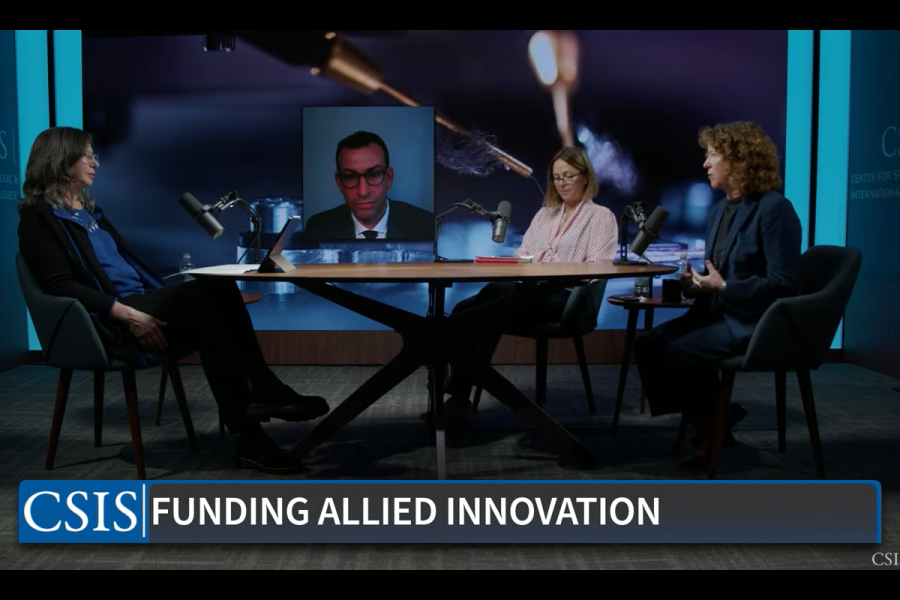NATO has taken a page from the Air Force’s innovation playbook, setting up a technology accelerator and a venture fund to nurture and financially support small companies working on cutting edge technology development in critical fields.
“The U.S. has been really doing a lot of very important work … and many of the European countries, the U.K. and others, are really trying to learn from that and do that themselves,” Dame Fiona Murray, vice chair of the board of directors for the NATO Innovation Fund (NIF), said during an event at the Center for Strategic and International Studies on Nov. 7.
In a later email to Air & Spaces Forces Magazine, Murray specifically cited the work done by the U.S. Air Force’s AFVentures team, as well as the National Security Strategic Investment Fund in the UK as the inspiration for NIF’s work.” Established in 2020, AFVentures makes small (under $2 million) initial awards in two stages to companies prototyping new technologies that the Air Force can use.
The NATO fund, launched last year, has 1 billion euros, or just over $1.08 billion, contributed by the governments of 24 of the 32 NATO member states, said Murray, who is also professor of entrepreneurship and associate dean of innovation at the MIT Sloan School of Management. The fund, which is structured as a standalone entity without formal links to NATO, will make investments by purchasing equity in early stage startups, just like private sector venture capitalists do, but with a couple of important differences, she explained.
First, the fund was structured to make investments that would mature in about 15 years, as opposed to the 7-10 year timeline commercial VC funds tend to operate on. “That allows us to be, let me call it, impatiently patient,” Murray said, explaining that NIF wants to make sure businesses have time to mature, but they also want to deploy the technologies they were developing “as rapidly as possible.”
Second, the fund trains and helps equip the startups it funds to protect their intellectual property from cyber theft. “We really pay attention to protecting our companies, to making sure that they protect the ideas that they’re developing from adversaries and that they are security minded right at the get go,” she said.
Third, just like the Air Force innovation accelerator AFWERX, NIF offers its companies training, support, and mentorship to help navigate the complex and difficult process of bidding for and winning military contracts. “We support our portfolio companies in … making their way through the labyrinth of different institutional structures and mechanisms that can allow them to be successful,” she said.
That process is especially complicated by the absence of a common framework or even language for technology assessment among the different member states, Murray added. “One of the things that would help us tremendously is if we could develop a better shared language,” she said. Reciprocity between NATO militaries would help speed the best ideas to the widest possible adoption.
“We need a way for saying, ‘OK, we have evidence that something worked,’” and for that to be acceptable in another country; or for a mechanism by which competition winners in one nation could get credit for that in another nation’s acquisition process. “That’s when we begin to really smooth the path for some of the best companies,” she said.
Many of the companies getting NIF investments will have been originally developed and nurtured by the Defence Innovation Accelerator for the North Atlantic, or DIANA, added Barabar McQuiston, chair of the DIANA governing board. Unlike NIF, DIANA is a formal NATO organization, covering all 32 NATO member-states, with hubs in Estonia, the U.K., and Canada. DIANA also works with a network of more than 20 affiliated accelerator sites and around 180 test centers in innovation clusters all over the alliance, she said.
DIANA will gives grants and in-kind assistance to startups in nine technology areas (next-gen communication networks; AI; autonomy; quantum-enabled technologies; biotechnology and human enhancement; energy and propulsion; novel materials and manufacturing; and aerospace), and launched challenges in three of them last year, McQuiston said. Out of 1,300 proposals, 44 were selected for as the first cohort for phase one—winning the companies a six-month stint in a local accelerator to start work turning their ideas into businesses. Ten of those have progressed through a competition to phase two, test and experimentation, she said.
Four of the phase two participants had taken part in a recent NATO exercise in Italy, McQuiston said.
“That’s important, because then we can really see how the technology is doing,” she said. The companies “can engage with the end user and … can really get a good feeling for what’s needed in the security market to meet the demands and the needs [of the warfighter], or even think of whole new solutions and capabilities that could be an advantage for us.”
Five more challenges will be launched this year, and DIANA aims to get 75 companies on contract for the next phase one cohort, McQuiston said, adding that the aim of DIANA and NIF together is to create an ecosystem that can take an idea and develop it through early stage prototyping and development, all the way through military contracting to full-blown commercialization.
